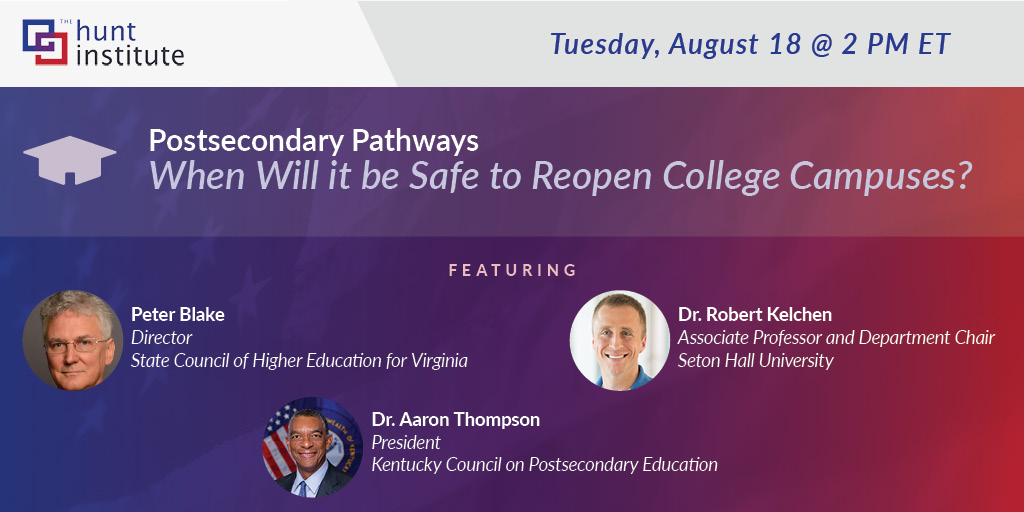

August 30, 2020
 “Campus looks different now. Colleges are struggling with what they’ll do for the fall semester…it’s a brutal environment.”
“Campus looks different now. Colleges are struggling with what they’ll do for the fall semester…it’s a brutal environment.”
-Dr. Robert Kelchen
Throughout the summer, some of the smartest minds in higher education have been focused on this moment: the start of the fall 2020 semester. Students and their families have dealt with months of uncertainty as they wait to hear whether their postsecondary options would involve remote learning, in-person courses, or some sort of hybrid approach. Meanwhile, institution leaders have been consulting with public health officials and carefully crafting plans to resume courses in the safest way possible.
On the most recent installment of our Postsecondary Pathways webinar series, we heard from leading state higher education policymakers – Peter Blake from the State Council of Higher Education for Virginia (SCHEV) and Dr. Aaron Thompson from the Kentucky Council on Postsecondary Education (CPE) – about the guidance they’re providing to schools in their state. Peter and Aaron were joined by Dr. Robert Kelchen from Seton Hall University, who has been tracking and analyzing nationwide trends in campus reopening announcements. The three experts shed some light on how some of these reopening decisions are being made.
The decisions faced by college and university leaders vary considerably based on a number of factors including funding sources, campus infrastructure, student population served, remote learning capabilities, and more. As our guests shared what they’ve been hearing from institutions, the importance of community partnerships came up again and again. These partnerships can help schools design and implement reopening plans with more robust safety protocols. Both Peter and Aaron cited examples of higher education institutions in their states that were able to leverage community partnerships with medical schools and hospital systems to access testing materials and contract tracing systems. Robert added that some community colleges that have reopened successfully (to date) have done so with the support of community partners.
“Working with the local community is important and relationships with regional health departments are valuable.”
–Peter Blake
The webinar discussion also highlighted how community partnerships can inform real-time decision making about campus reopening plans. Aaron talked about how each institution leader in Kentucky faces a different decision, and many of them are looking at dashboards of different data sources to draw insight. Many of the data points that can inform these decisions should be drawn from community sources, especially local public health departments, so that reopening plans can account for risk levels associated with the community surrounding the campus.
Toward the end of the discussion, the panelists talked about how this pandemic may have long-term effects on how institutions think about course delivery models. Aaron acknowledged that many aspects of our current higher education system have been designed around in-person engagement, but he also emphasized that any effort to reimagine higher education should not start from scratch – we should build on and replicate the things that have been proven to work for students.
Peter noted the significant expansion in opportunities for online learning options that we will see in the coming years, and noted that higher education institutions in Virginia have already converted over 30,000 courses to online learning platforms. But he also cautioned that the expansion of online learning should be designed to narrow the equity gaps that exist in higher education. Lastly, Robert noted that many institution leaders are too focused on immediate needs to be thinking about long-term challenges – although many do recognize the need to build out their online learning infrastructures.
“In a time of short revenue and COVID-19, it will take higher education to get us through this pandemic and build the long-term infrastructure that will be needed to thrive.”
– Dr. Aaron Thompson
The hour-long conversation also covered a number of other interesting topics, including training teachers to use remote learning platforms, legal liabilities associated with campus reopening, and challenges associated with resuming in-person coursework. The full discussion is available through the video recording below.